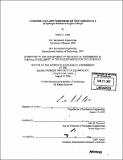| dc.contributor.advisor | John B. Heywood. | en_US |
| dc.contributor.author | Ayala, Ferran A. (Ferran Alberto), 1976- | en_US |
| dc.contributor.other | Massachusetts Institute of Technology. Dept. of Mechanical Engineering. | en_US |
| dc.date.accessioned | 2007-08-03T18:22:43Z | |
| dc.date.available | 2007-08-03T18:22:43Z | |
| dc.date.copyright | 2006 | en_US |
| dc.date.issued | 2006 | en_US |
| dc.identifier.uri | http://hdl.handle.net/1721.1/38262 | |
| dc.description | Thesis (Ph. D.)--Massachusetts Institute of Technology, Dept. of Mechanical Engineering, 2006. | en_US |
| dc.description | Includes bibliographical references (p. 197-199). | en_US |
| dc.description.abstract | Operating an engine with excess air, under lean conditions, has significant benefits in terms of increased engine efficiency and reduced emissions. However, under high dilution levels, a lean limit is reached where combustion becomes unstable, significantly deteriorating drivability and engine efficiency, thus limiting the full potential of lean combustion. Due to hydrogen's high laminar flame speed, adding a hydrogen-rich mixture with gasoline into the engine helps stabilize combustion, extending the lean limit. This work studies the fundamental behavior of lean combustion in a spark ignition (SI) engine, identifying the processes that determine the engine's efficiency curve, and studying practical solutions to extend the peak efficiency and the lean limit. Lean and hydrogen-enhanced combustion data in a SI engine were generated covering a wide range of operating conditions including different compression ratios, loads, types of dilution, types and levels of hydrogen enhancement, and levels of turbulence. Combustion simulations were then performed to quantify the components that determine the efficiency vs. dilution curve. Results showed how burn duration is the primary driver of lean combustion, with a limiting 10-90% burn duration at peak efficiency and a limiting 0-10% burn duration at the onset of rapid combustion variability. | en_US |
| dc.description.abstract | (cont.) These two burn durations, while correlated, are affected differently by laminar flame speed and turbulence. Consequently the effect of hydrogen enhancement on combustion will depend on operating conditions. A flame entrainment combustion model was then used to fundamentally explain the observed criticalities in the experiments. The model properly captured the physics of the combustion process, accurately predicting the data and the basic trends. The model showed that the rapid increase in variability near the lean limit is due to the inverse dependence of the eddy-burning time on the laminar flame speed. This relationship causes the eddy-burning time to grow slowly and then rapidly with decreasing laminar flame speed, amplifying the baseline, normal, random variability associated with the flame initiation process. Due to the effect of initial conditions on combustion phasing, this increasing, but symmetric, variability during flame initiation will lead to asymmetrical variability in the main part of the combustion process. Modeling studies show how by reducing the eddy-burning time, the full burn duration curve can be shifted, extending the location of peak efficiency and the lean limit. | en_US |
| dc.description.abstract | (cont.) This can be done by increasing turbulence, effectively decreasing its microscale structure or by increasing the laminar flame speed through hydrogen enhancement. Hydrogen enhancement using reformate shows diminishing returns at high loads and high compression ratios due to the detrimental effect of high pressures on laminar flame speed. As suggested by the model, reducing the engine's baseline combustion variability during flame initiation can also extend the lean limit. These conclusions are confirmed through experimental results. | en_US |
| dc.description.statementofresponsibility | by Ferrán A. Ayala. | en_US |
| dc.format.extent | 205 p. | en_US |
| dc.language.iso | eng | en_US |
| dc.publisher | Massachusetts Institute of Technology | en_US |
| dc.rights | M.I.T. theses are protected by copyright. They may be viewed from this source for any purpose, but reproduction or distribution in any format is prohibited without written permission. See provided URL for inquiries about permission. | en_US |
| dc.rights.uri | http://dspace.mit.edu/handle/1721.1/7582 | |
| dc.subject | Mechanical Engineering. | en_US |
| dc.title | Combustion lean limits fundamentals and their application to a SI hydrogen-enhanced engine concept | en_US |
| dc.type | Thesis | en_US |
| dc.description.degree | Ph.D. | en_US |
| dc.contributor.department | Massachusetts Institute of Technology. Department of Mechanical Engineering | |
| dc.identifier.oclc | 151029459 | en_US |
